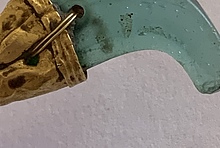Home PageAbout MindatThe Mindat ManualHistory of MindatCopyright StatusWho We AreContact UsAdvertise on Mindat
Donate to MindatCorporate SponsorshipSponsor a PageSponsored PagesMindat AdvertisersAdvertise on Mindat
Learning CenterWhat is a mineral?The most common minerals on earthInformation for EducatorsMindat ArticlesThe ElementsThe Rock H. Currier Digital LibraryGeologic Time
Minerals by PropertiesMinerals by ChemistryAdvanced Locality SearchRandom MineralRandom LocalitySearch by minIDLocalities Near MeSearch ArticlesSearch GlossaryMore Search Options
The Mindat ManualAdd a New PhotoRate PhotosLocality Edit ReportCoordinate Completion ReportAdd Glossary Item
Mining CompaniesStatisticsUsersMineral MuseumsClubs & OrganizationsMineral Shows & EventsThe Mindat DirectoryDevice SettingsThe Mineral Quiz
Photo SearchPhoto GalleriesSearch by ColorNew Photos TodayNew Photos YesterdayMembers' Photo GalleriesPast Photo of the Day GalleryPhotography
╳Discussions
💬 Home🔎 Search📅 LatestGroups
EducationOpen discussion area.Fakes & FraudsOpen discussion area.Field CollectingOpen discussion area.FossilsOpen discussion area.Gems and GemologyOpen discussion area.GeneralOpen discussion area.How to ContributeOpen discussion area.Identity HelpOpen discussion area.Improving Mindat.orgOpen discussion area.LocalitiesOpen discussion area.Lost and Stolen SpecimensOpen discussion area.MarketplaceOpen discussion area.MeteoritesOpen discussion area.Mindat ProductsOpen discussion area.Mineral ExchangesOpen discussion area.Mineral PhotographyOpen discussion area.Mineral ShowsOpen discussion area.Mineralogical ClassificationOpen discussion area.Mineralogy CourseOpen discussion area.MineralsOpen discussion area.Minerals and MuseumsOpen discussion area.PhotosOpen discussion area.Techniques for CollectorsOpen discussion area.The Rock H. Currier Digital LibraryOpen discussion area.UV MineralsOpen discussion area.Recent Images in Discussions
PhotosArsenopyrite - Rod 2 mine, Snow Lake District, Manitoba, Canada

27th Mar 2015 17:31 UTCRichard Gunter Expert
27th Mar 2015 17:56 UTCRob Woodside 🌟 Manager
27th Mar 2015 18:02 UTCDavid Von Bargen Manager
Legenbach is a metamorphosed deposit so there is a good chance that the crystals grew in a solid medium (like garnet or staurolite crystals in schists).
27th Mar 2015 18:19 UTCRob Woodside 🌟 Manager

27th Mar 2015 18:19 UTCRichard Gunter Expert
All three of my examples have been noted as sulphosalt melts by Tomkins et al (2007): On the Initiation of Metamorphic Sulfide Anatexis, Journal of Petrology, v. 48 no.3 and other references therein. Tomkins has an interesting diagram where he has a Sartorite-Orpiment field (Sartorite usually occurs with Realgar) that has a maximum temperature of 300 C. This is well below the recorded melting temperature at Lengenbach of 500 C so the sample may be a retrograde melt at lower temperature than the peak.
Hi Rob:
If you use the analogue of a crystallizing melt in a layered silicate complex you do not have one phase (opx for example) crystallizing out in a fine grained second phase (anorthite in this case). All of the layered complexes I have seen have both cumulate phases being approximately the same grain size. The physics of a sulphosalt melt may be different than a silicate melt. I don't know if anyone has measured.

27th Mar 2015 18:31 UTCRichard Gunter Expert
Your second note came in while I was composing. Part of the problem at Lengenbach is that you have both melt and hydrothermal processes ongoing. In their Min Record article on Lengenbach Roth et al. (2014) have defined two separate sequences. The melt filled fractures, generally Realgar dominant, they call "Picassos". These are different than the hydrothermal vug filling with sulphosalt crystals. The Sartorite on this sample has been XRD identified so it is tied down. It puts a very tight temperature range on the melt as Sartorite converts to Baumhauerite at 300C. There are interesting melt-filled fractures on the sample where Sartorite filling converts to Realgar filling at a knife edge.
27th Mar 2015 19:11 UTCReiner Mielke Expert

27th Mar 2015 20:09 UTCRichard Gunter Expert
Thanks for the paper. I will have a look at it. There are many geological examples, with sulphosalt melts being the most recently investigated.
28th Mar 2015 00:01 UTCRob Woodside 🌟 Manager
"Cellular morphologies are those which exhibit periodic structures,
usually considered to be due to diffusion of heat or matter.
Cood examples are skeletal crystals and dendrites. Spherulites may
also be cellular structures, and will be considered so here."
I would have thought that the surface energy would determine whether the xl was euhedral or anhedral. The higher the surface tension the more spherical the growth, reducing the surface energy. Fast growing skeletons or dendrites must have very low surface energies to produce so much surface area in such a short time.
Richard, Thanks I've been meaning to read that Lengenbach article.

28th Mar 2015 22:38 UTCRichard Gunter Expert
Roth et al have very little to say about Sartorite from Lengenbach. considering it is one of the major sulphosalts, especially in the old quarry, There is still a lot that is unknown about Sartorite. The sample itself was collected in 1959, well before there was any thought of sulphosalt melting so I wonder how many of the 1950's Lengenbach Sartorite samples have melt textures. The Chisel Mine and Rod Mine samples were collected before the sulphosalt melting theory was widespread and they also contain textures that could not be understood until long after the samples were taken.




Mindat.org is an outreach project of the Hudson Institute of Mineralogy, a 501(c)(3) not-for-profit organization.
Copyright © mindat.org and the Hudson Institute of Mineralogy 1993-2024, except where stated. Most political location boundaries are © OpenStreetMap contributors. Mindat.org relies on the contributions of thousands of members and supporters. Founded in 2000 by Jolyon Ralph.
Privacy Policy - Terms & Conditions - Contact Us / DMCA issues - Report a bug/vulnerability Current server date and time: May 14, 2024 15:30:46
Copyright © mindat.org and the Hudson Institute of Mineralogy 1993-2024, except where stated. Most political location boundaries are © OpenStreetMap contributors. Mindat.org relies on the contributions of thousands of members and supporters. Founded in 2000 by Jolyon Ralph.
Privacy Policy - Terms & Conditions - Contact Us / DMCA issues - Report a bug/vulnerability Current server date and time: May 14, 2024 15:30:46













